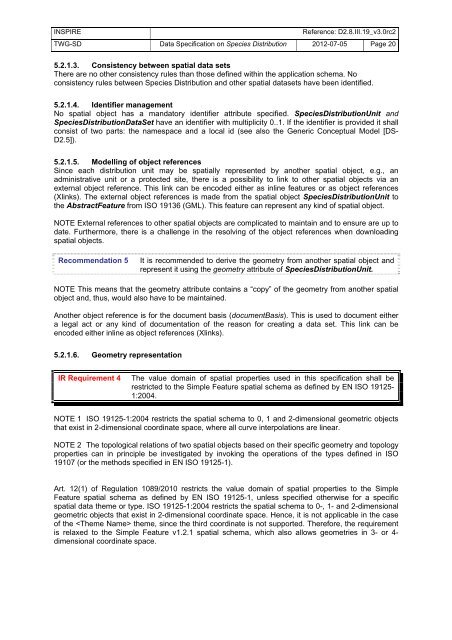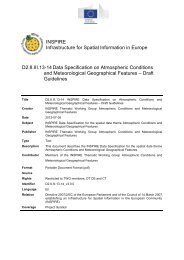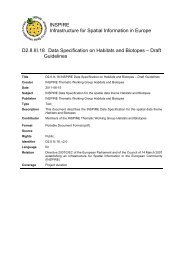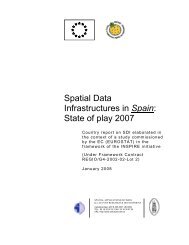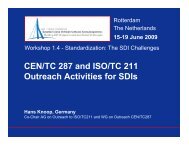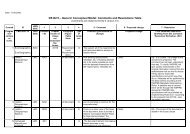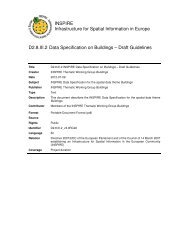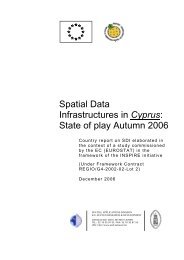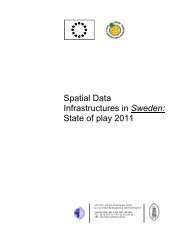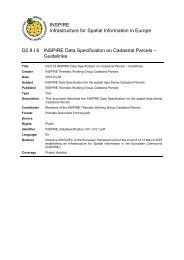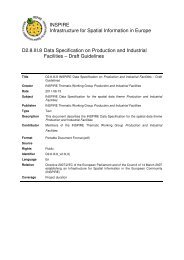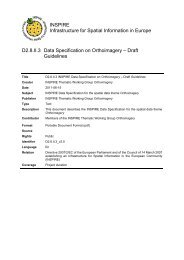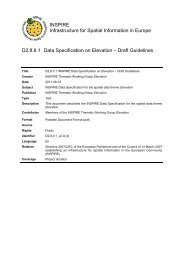Download Version 3.0 rc2 - Inspire - Europa
Download Version 3.0 rc2 - Inspire - Europa
Download Version 3.0 rc2 - Inspire - Europa
You also want an ePaper? Increase the reach of your titles
YUMPU automatically turns print PDFs into web optimized ePapers that Google loves.
INSPIRE Reference: D2.8.III.19_v<strong>3.0</strong><strong>rc2</strong><br />
TWG-SD Data Specification on Species Distribution 2012-07-05 Page 20<br />
5.2.1.3. Consistency between spatial data sets<br />
There are no other consistency rules than those defined within the application schema. No<br />
consistency rules between Species Distribution and other spatial datasets have been identified.<br />
5.2.1.4. Identifier management<br />
No spatial object has a mandatory identifier attribute specified. SpeciesDistributionUnit and<br />
SpeciesDistributionDataSet have an identifier with multiplicity 0..1. If the identifier is provided it shall<br />
consist of two parts: the namespace and a local id (see also the Generic Conceptual Model [DS-<br />
D2.5]).<br />
5.2.1.5. Modelling of object references<br />
Since each distribution unit may be spatially represented by another spatial object, e.g., an<br />
administrative unit or a protected site, there is a possibility to link to other spatial objects via an<br />
external object reference. This link can be encoded either as inline features or as object references<br />
(Xlinks). The external object references is made from the spatial object SpeciesDistributionUnit to<br />
the AbstractFeature from ISO 19136 (GML). This feature can represent any kind of spatial object.<br />
NOTE External references to other spatial objects are complicated to maintain and to ensure are up to<br />
date. Furthermore, there is a challenge in the resolving of the object references when downloading<br />
spatial objects.<br />
Recommendation 5 It is recommended to derive the geometry from another spatial object and<br />
represent it using the geometry attribute of SpeciesDistributionUnit.<br />
NOTE This means that the geometry attribute contains a “copy” of the geometry from another spatial<br />
object and, thus, would also have to be maintained.<br />
Another object reference is for the document basis (documentBasis). This is used to document either<br />
a legal act or any kind of documentation of the reason for creating a data set. This link can be<br />
encoded either inline as object references (Xlinks).<br />
5.2.1.6. Geometry representation<br />
IR Requirement 4 The value domain of spatial properties used in this specification shall be<br />
restricted to the Simple Feature spatial schema as defined by EN ISO 19125-<br />
1:2004.<br />
NOTE 1 ISO 19125-1:2004 restricts the spatial schema to 0, 1 and 2-dimensional geometric objects<br />
that exist in 2-dimensional coordinate space, where all curve interpolations are linear.<br />
NOTE 2 The topological relations of two spatial objects based on their specific geometry and topology<br />
properties can in principle be investigated by invoking the operations of the types defined in ISO<br />
19107 (or the methods specified in EN ISO 19125-1).<br />
Art. 12(1) of Regulation 1089/2010 restricts the value domain of spatial properties to the Simple<br />
Feature spatial schema as defined by EN ISO 19125-1, unless specified otherwise for a specific<br />
spatial data theme or type. ISO 19125-1:2004 restricts the spatial schema to 0-, 1- and 2-dimensional<br />
geometric objects that exist in 2-dimensional coordinate space. Hence, it is not applicable in the case<br />
of the theme, since the third coordinate is not supported. Therefore, the requirement<br />
is relaxed to the Simple Feature v1.2.1 spatial schema, which also allows geometries in 3- or 4dimensional<br />
coordinate space.


